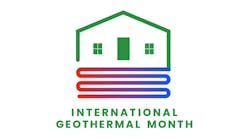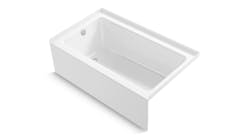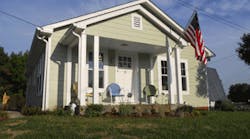Latest from Green
Sponsored
RICHMOND, VA. — James River Air Conditioning, local HVAC contractor, has renovated a 1939 cinder block bungalow here into the area's first U.S. Green Building Council LEED Platinum certified home, which is being used as a laboratory for sustainable strategies and products.
The Solar Cottage I was designed to allow clients to see, first hand, sustainable products and technologies. Since the renovation was completed, the house has been open to building groups and architects, and in the near future the house will be open to the public, so people can learn about the variety of sustainable technologies in the home.
According to Hugh Joyce, president of James River Air Conditioning, it made sense to renovate the old home with sustainable technologies since many of his customers are becoming more interested in green technologies and want to see a working example of products.
“When you get into green initiatives with more expensive products, customers want to see the product in a project and touch it,” said Joyce. “So, I decided to fix up an old house and install products and create a model-like home. We are showcasing a variety of technologies, including solar power. We also decided to certify the project LEED, and when we started working on scoring, we realized we could be a LEED Platinum house, the first of its kind in Richmond.”
Joyce bought the bungalow in Jan. 2010 and started the renovation in March. It took approximately five and a half months.
“It’s an awesome little model home that we are in every day with a group of people that want to see sustainable technologies, so basically it has become a working laboratory,” said Joyce. “What we like is the house is located near a five lane and seven lane intersection, so thousands of cars go by it every day and people see it. It’s in a high profile spot.”
Showcasing systems
The home is utilizing solar PV power generation via Kyocera 225 kW panels, which were chosen based on a recommendation from a distributor partner and because they are the widest per square inch and assembled in the U.S.A.
According to Joyce, on most sunny days more power is produced than what is used.
“We use a grid-tied net-metering configuration with our solar system,” said Joyce. “When the sun is out we make more power than we use (meter runs backwards) at night and on cloudy days or when we need lots of power our meter runs forward. There is no battery storage.”
The home also showcases a Westinghouse IQ Drive Variable Speed DC Inverter heat pump.
“We are convinced this is the most efficient air-to-air heat pump in the world,” said Joyce. “It has a 24 SEER rating and a 10 HSPF. In addition to that with the start-stop technology we are just seeing incredible efficiency out of this. We think this unit performs near geothermal efficiency levels.
“Let’s assume you had ductwork and you wanted a Westinghouse heat pump vs. a geothermal heat pump with an underground loop,” Joyce continued. “A Westinghouse 2-ton heat pump on a job like this would be about $12,900 and a 2-ton geothermal would be about $23,000.
“Now the geothermal heat pump would qualify for a 30% tax credit and only $5,000 of the air-to-air would qualify for the tax credit, but there is somewhere between $6,000 - $10,000 more to go towards a geothermal heat pump, and we know that you would never pay back the difference. All this is specific to the Richmond, Va., area. But, of course in certain applications the geothermal makes sense where you can’t have outdoor units or you are in a colder climate, but in Virginia we have relatively mild weather.”
Not only does The Solar Cottage I showcase energy-efficient technologies, it also showcases technologies and products that conserve water. Toto toilets are being used with a clear flush and black flush, and instead of buying low-flow plumbing fixtures, Joyce opted to buy standard fixtures and put flow restrictors on them. There is also a graywater recovery system used for irrigation and a rainwater system in which rain is captured from the roof in a 1,300-gal cistern. The home’s domestic hot water is produced via an electric tankless unit.
“We are configured to use rainwater for toilets and laundry, but right now we are only using it for irrigation,” said Joyce. “In the foreseeable future we plan to use the rainwater to flush the toilets and wash clothing.”
Monitoring the house
The Energy Detective (TED) kW power monitor and Google PowerMeter are being used to monitor the systems of the home and how much energy each system is utilizing. The Google PowerMeter is a free energy monitoring tool, helping homeowners view their home's energy consumption from anywhere online. Smart Home controls are also used, so the systems in the house can be controlled from anywhere.
“We use TED to monitor solar panels and other systems in the house,” said Joyce. “All of that data from TED goes into Google PowerMeter and the power usage is reported all the time in Google PowerMeter to see how the house is doing.”
Other sustainable features showcased in the home include a Honeywell ERV ventilation system, LED lighting, Energy Star appliances, and high-performance foam insulation and envelope sealing.
“We used Icynene foam insulation on this project and did a foam conditioned crawl space, put foam in all the walls and attic deck, so the house is like an igloo cooler, it’s super tight,” explained Joyce. “And that is the key piece of making a house near net-zero, is making a good insulation package.”
Joyce told CONTRACTOR that so far, he is pleased with the house’s utility bills. He is running the appliances, hot water, etc., in the house in order to see what the monthly utility costs are.
According to Joyce, the bills were $28 for September; $23 for October; and $16 for November. He is forecasting that the house will have a total yearly utility bill between $200 and $300 compared to a conventional house of the same size, which would be around $1,400 - $1,500.
“This model home is an incredible sales tool to put all your technologies in,” said Joyce. “It’s very neat when it’s a LEED Platinum house too. I encourage contractors and everyone to get out and have fun with this sustainable, renewable approach to living.”
Based on this project, a green team is evolving at James River Air Conditioning. At this time, the HVAC contractor is putting together a separate subsidiary for its residential and commercial group.
Candace Roulo
Candace Roulo, senior editor of CONTRACTOR and graduate of Michigan State University’s College of Communication Arts & Sciences, has 15 years of industry experience in the media and construction industries. She covers a variety of mechanical contracting topics, from sustainable construction practices and policy issues affecting contractors to continuing education for industry professionals and the best business practices that contractors can implement to run successful businesses.


